Quality of the Environment in Japan 1992
a. Vegetation
According to data provided by the 1988 survey, 92.7 percent of Japan's entire land area consisted of land covered with natural or cultivated vegetation. Forested lands covered 67.5 percent of the entire area (Table 1-2-1).
However, a careful examination of these data reveals that rela-tively little land is preserved in its natural state. Virgin vegetation can be classified into the following five categories: frigid or alpine zone vegetation represented by alpine plants and shrubs; sub-alpine and sub-frigid vegetation such as birch or fir trees; natural vegetation of the beech variety represented by beech forests; dipterocarp natural vegeta-tion represented by glossy-leaved plants such chinquapin or oak; and vegetation found alongside rivers, in swamps and marshes, in salt marshes, and in areas of sand dunes. In total, all of these areas represent only 19.3 percent of the total land area. Almost 60 percent of these natural areas are located in Hokkaido, plus a limited amount in steep mountain areas, peninsulas, and outlying islands. Forests possess such a capacity to provide an abundant supply of water that they could be referred to as "green reservoirs." Forests in their natural state remain a precious natural resource that provide a habitat for numerous species of wildlife.
Flat or hilly land close to human activity regions are mainly secondary forests that have regrown where wood had been harvested for fuel, artificially reforested areas, and land under cultivation. Secon-dary forests are composed of thickets of various oak species, pine forests, and coppice forests of chinquapin and oak, and they cover nearly one quarter (24.6 percent) of the land area. They are located near areas of human habitat in, and although not virgin, their proximity makes them a valuable source of greenery.
Artificially reforested or cultivated land makes up approximately one half (47.4 percent) of the total land area. Most of the trees found in these areas are of the cedar or cypress varieties.
According to vegetation trends revealed by the first, second, and third greenery census, conducted in 1973, 1979, and from 1983 to 1986 respectively, there has been little change in the overall area of forested land. However, primary and secondary growth forests have decreased by 3.9 percent, and reforested areas have increased by 4.1 percent (Table 1-2-2).
Although over half of Japan is covered with vegetation, most of this greenery has been planted or cultivated by man, and natural, primary forests only remain in very limited areas.
Table 1-2-1 Vegetation by Degree of Naturalness
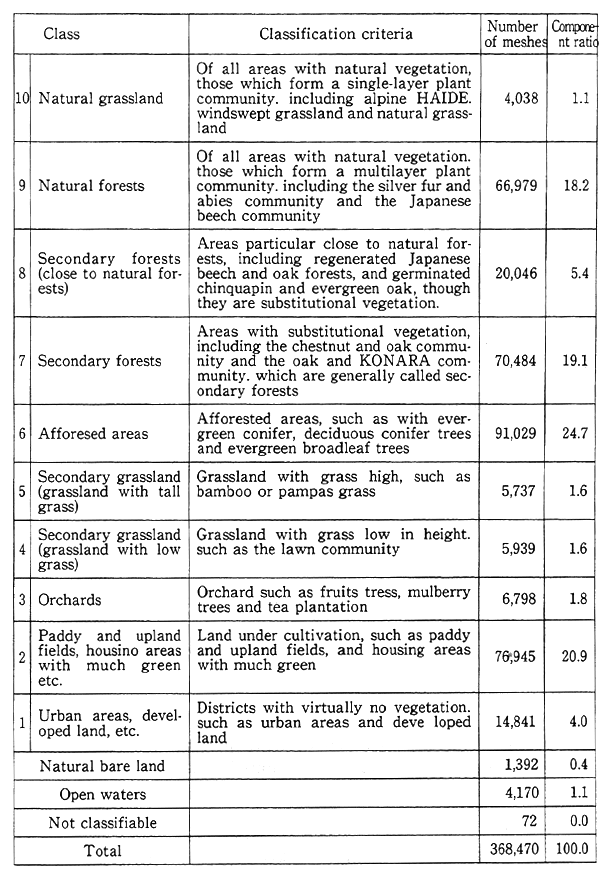
Source: Environment Agency 2nd and 3rd National Green Census (1979,1983-86)
Table 1-2-2 Changes in Vegetation
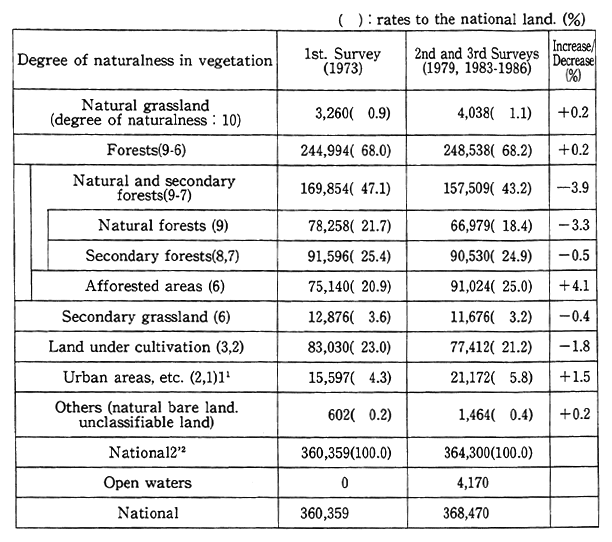
* 1. The urban areas, etc., include housing areas with much green (degree of naturalness in vegetation: 2).
* 2. Excluding open waters. As open waters were not covered in the 1st Survey, the open waters are excluded in calculating component ratios in this comparison of survey findings to check in creases or decreases. Therefore, the component ratios of the degrees of natural-ness in vegetation in the 2nd and 3rd Surveys are different from the afore-mentioned national rates.
Source: Environment Agency
b. Lakes
There are a large number of lakes in Japan. A national survey of lakes (natural lakes over 1 ha in area) conducted by the Environment Agency has shown that lakes cover a total of 2,308.08km2 or 0.63 percent of the entire land area. These lakes vary in type from those which are located in mountain regions, to the inland sea-lake types left by the retreating ocean in flatlands or near coastal regions. Water transparency of these lakes is detailed in Table 1-2-3.
Table 1-2-3 Lakes and Reservoirs with High Transparency
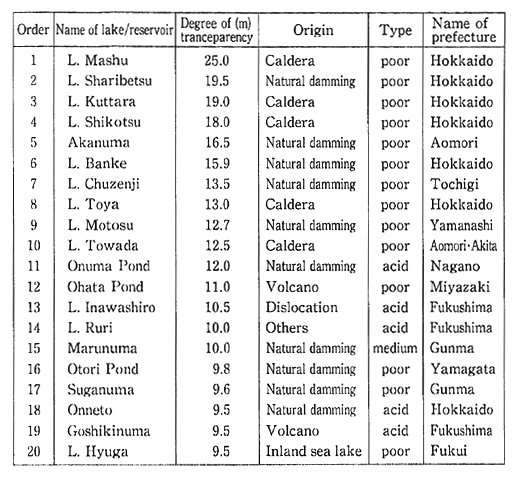
Source : Environment Agency
Lakeshore alteration reflects utilization conditions. More than 50 percent of the existing lakeshore is artificial. Furthermore, over 30 percent of the lakeshore has been developed for industrial or urban use. From 1979 to 1985, the number of lakes classified as "advanced altera-tion lakes," has increased from 19 to 27. These are all of the inland-sea variety and are located in plains areas. Also, since 1945, land reclama-tion has been carried out at 57 lakes, reducing total lake surface area by approximately 344km2 or 13 ercent. These lake areas have been re-placed by various types of land utilization such as industrial, urban, or agricultural.
Lakes are an important natural habitat. Table 1-2-4 shows those lakes in which there is a large number of fish species. It is clear that the number of species is particularly abundant in inland-sea lakes where coastal and brackish fish can enter.
Table 1-2-4 Lakes and Reservoirs Inhabited by Many Fish Species
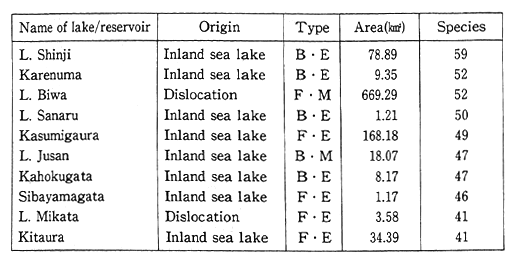
Source: Environment Agency
The introduction of non-indigenous fish is also taking place at lakes in every area. As this is one of the factors affecting changes among fish species, it is important to continue monitoring these trends.
c. Rivers
Surveys on natural environments were carried out on the main arteries of 113 class one rivers in 1979 and 1985.
In 1985, of the 11,412km of surveyed riverbank, artificial river-bank (structures such as river dikes in contact with the river surface at normal river conditions) accounted for 2,441.5km or 21.4 ercent. I comparison with 1979, this represented an increase of 249.3km or 2.2 percent of total length of riverbank (Figure 1-2-4).
Concerning the current state of river beaches, approximately one third was natural vegetation, followed by agricultural land, and then land for spacial facilities. The amount of natural land is decreasing and the proportion of agricultural land, and land for sports facilities is increasing.
Fig. 1-2-4 Changes in River Shorelines
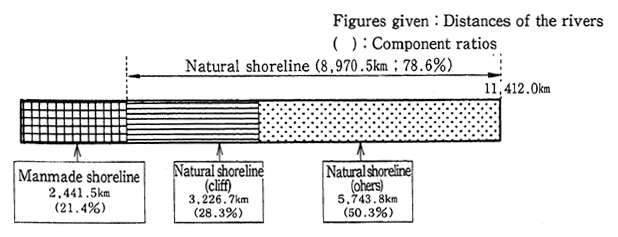
Note: A change in the shoreline are expressed by the average of the right and left river banks.
Source: Environment Agency 3rd National Green Census 1985
Dams and other structures spanning rivers may divide up natural fish habitats unless proper measures to enable fish to swim upstream. Only 13 of ll3rivers surveyed (Abashiri River, Kushiro River, Uranai River, Tokoro River, Rumoi River, Atoshiribetsu River, Omono River, Tenjin River, Takase River, Natori River, Tokachi River, Kuji River and Haji River) were free of river spanning structures or did not hinder fish from moving upstream (Table 1-2-5). There were an additional 9 rivers, (Ibo River, Hino River, Iwaki River, Nagara River, Maruyama River, Shimanto River, Mogami River, Yoneshiro River and Naka River), for which the navigable distance (distance from the river mouth to the furthermost point to which fish can return upstream) for ana-dromous fish exceeded 90 percent of the river length. This produced a total of 22 rivers, or 19 percent of the surveyed rivers. On the other hand, there were 6 rivers, such as Ashida River, for which the navigable distance was less than 10 percent of total river length. Overall, the average proportion of the navigable distance to total river length was 58.9 percent for all rivers surveyed.
Rivers provide a habitat for a variety of fish and other organisms. Table 1-2-6 lists rivers which support a particularly large variety of fish species. Many of these rivers are in Honshu.
d. Coast
According to a survey conducted in 1984, Japan had a total of 32, 471km of coastline. Of this, 58.3 percent was along the main islands, and 41.7 percent along the outlying islands. As a result of ongoing land reclamation, this coastline is gradually lengthening. Classified by type, 56.7 percent of the entire coastline is natural, 28.6 percent is artificial, and 13.9 percent is semi-natural. Excluding the outer islands, less than one half (46.0 percent) of the coastline is natural, and more than a third (36.5 percent) is artificial (Figure 1-2-5). Changes in coastline from 1978 to 1984 show that natural coastline decreased 565km, artificial coastline increased 696km, and semi-natural coastline increased 171km. This represented a decrease in sandy beaches and rocky coasts, and an increase in coastline provided by land reclamation (Figure 1-2-6).
Table 1-2-5 Rivers Ascendable by Fish (with the rate of the ascendable section at 100%)
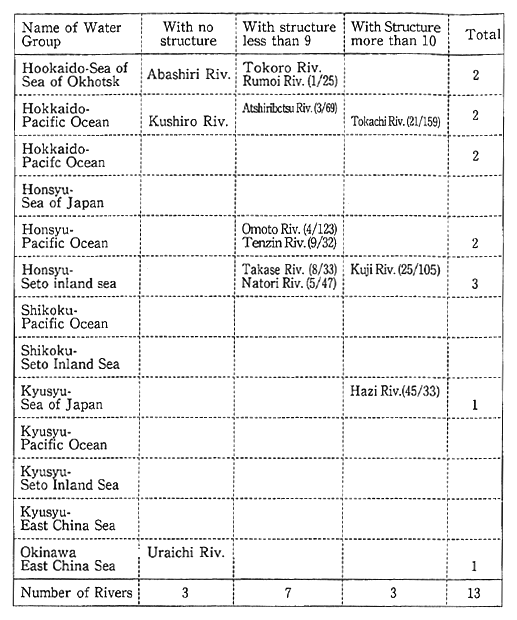
Table 1-2-6 Rivers with Many Fish Species
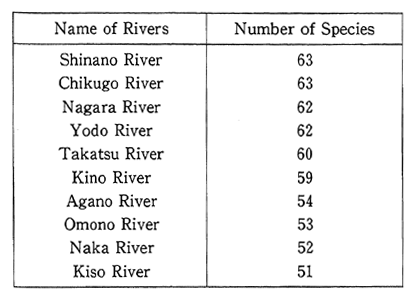
Note; Living species observed or heard about
Source: Environment Agency 3rd National Green Census (1985)
e. Natural landscape
Japan is endowed with magnificent topography, geological fea-tures, and natural phenomena such as waterfalls, canyons and mountain-ous areas. This endowment serves valuable functions as symbols for communities, resources for tourism, objects for study, and finally, as places where people can go to regain their sense of being a part of nature. According to a 1988 survey, Japan had a total of 15,468 such natural wonders. Most numerous were waterfalls (2,488), followed by volcanoes (1,158), valleys and canyons (993), non-volcanic mountain peaks (993), lakes (872), and sandy beaches and seashores (632), together accounting for approximately one half of all the wonders.
Among all of these locations, 57.8 percent are protected as natural parks, natural conservation areas, or natural monuments. The remainder is also protected under such schemes as protected forest status (state owned forest) and prefectural ordinances to protect regional natural areas. Of these natural landscape resources, approxi-mately two thirds have already suffered impacts from development. In most of these cases, damage has resulted from unlimited access for sightseers, followed by agricultural or forestry development and tour-ism development.
Fig.1-2-5 Coastal Shoreline Classifications
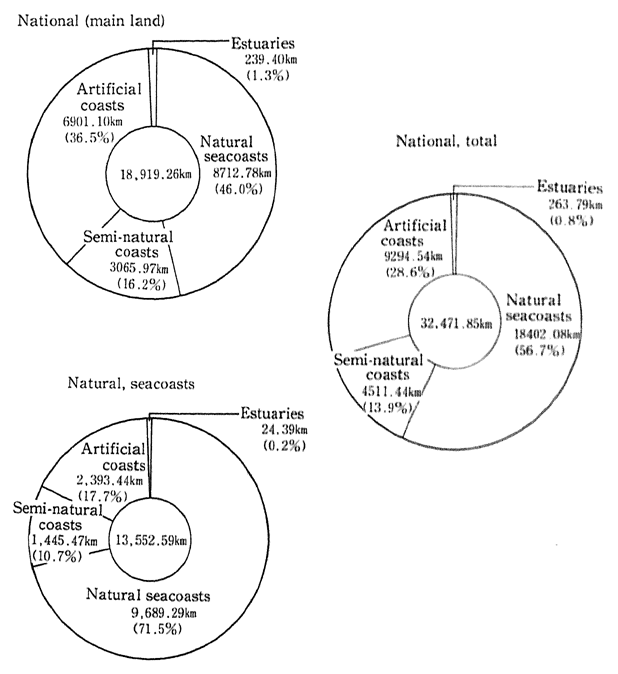
Source; Environment Agency 3rd National Green Census (1984)
Note:
a; Islands in this survey do not include those which have diameter less than 100m. (not include Northern territory either)
b; Mainland includes Hokkaido, Honsyu, Shikoku and Kyusyu.
c; Classification of shoreline is Natural; those which have no artificial construction in the shore Semi-natural: those which have no artificial construction in the shore, but have some just above the shore (directly affectde by wave) Artificial: those which have some artificial construct ion in the shore.
Fig. 1-2-6 Changes in Shorelines
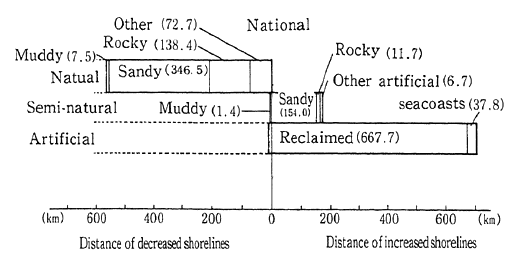
Source: Environment Agency
(3) The Natural Environment in Urban Areas
Although we may be apt to overlook the greenery that constitutes our immediate surroundings, or the plants and animals with which we are most familiar, these are indispensable for maintaining our lives in harmony with nature. For example, by mitigating the heat island effect, these natural surroundings benefit our environment and improve mete-orological conditions. They also serve as environmental indicators concerning the quality of city air, water and soil.
The National Survey on Natural Environment classifies vegeta-tion on a ten point scale reflecting the degree to which it is influenced by human activity. These ten points can be grouped into the following five categories: natural, secondary, afforested, agricultural, and urban. Examining the natural state of the capital district (metropolitan Tokyo, and Kanagawa, Saitama, and Chiba prefectures), Aichi Prefecture, and Osaka Prefecture, it is immediately apparent that natural vegetation in all of these areas is considerably less than the national average, and that the proportion of towns and cities with little greenery is much higher than in other parts of the country (Figure 1-2-7). In the suburbs, secon-dary vegetation provides a natural environment that is near at hand and creates a habitat for many plants and animals. However even this vegetation is sparse. Since 1980, changes in land utilization in the capital district have resulted in a decrease in secondary and agricultural vegeta-tion, and an increase in afforested or urban vegetation.
Fig. 1-2-7 State of Vegetation in Three Major Urban Regions
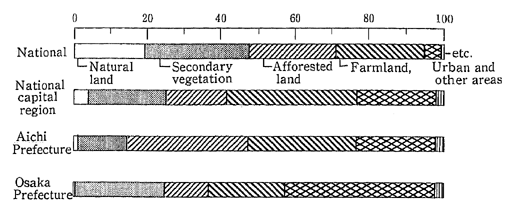
Source : Environment Agency
(4) State of Nature in Developing Countries
Most of the people living in the developing countries (approxi-mately two thirds of the population in Asia and Africa) are employed in primary industries such as agriculture, forestry, or fishing. These peo-ple's lives depend in large measure upon natural resources.
The forests, wildlife, and soil that constitute their natural envi-ronment provide them with fuel, food, water, construction materials, and fodder for their livestock. This natural environment also helps to prevent floods, regulate the weather, and safeguard people's lifestyles as the target of their economic activity. Many of the developing countries are teeming in natural resources that form a precious heritage with immeasurable value for the entire world. However due to increasing industrialization, these countries are falling victim to the same proces-ses that led to the loss of natural environment resources in the indus-trialized countries. Moreover, poverty and population pressures in these countries are aggravating excessive resource utilization, and as a result, the stock of natural resources is gradually being depleted. Below, we shall examine the conditions affecting these resources in the developing countries by focusing on forests and soil especially in Asia.a. Forests
In 1987, world forests were estimated to cover 4.07 billion hec-tares. Out of this total, Asia (excluding Japan) accounted for 513.70 million ha, South America for 899.96 million ha, Africa for 686.34 million ha, and North America (excluding Canada and the United States) for 66. 52 million hectares. This produced a total of 2.17 billion ha in developing countries, or 53.25 percent of the world total (Table 1-2-7).
Table 1-2-7 World's Forest Resources
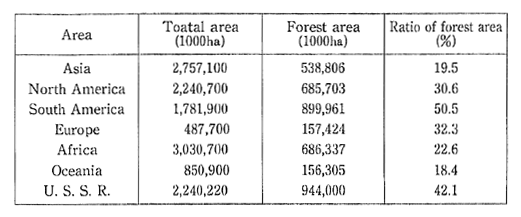
Source FAO, Farest Products Yearbook 1888
Most of the forests in developing countries are tropical forests, the deforestation of which is a matter of global concern. The second interim report of the "Forest Resources Assessment 1990 Project" of the Food and Agriculture Organization of the United Nations (FAO) was delivered at the 10th World forestry Congress in September 1991 Although the report was only previsional (in particular, it did not contain data for all of the countries of Africa) it illustrated the rate of deforestation of 87 tropical countries between 1980 and 1990 (Table 1-2-8). According to this report, in these 87 countries there was a total deforestation averaging 17.00 million ha, or 0.9 percent per year. In comparison, in 1981, the FAO/UNEP published its 1980 Forest Resources Assessment which estimated an average 0.6 percent yearly rate of deforestation for 1980 to 1985 in the 76 countries targeted by both reports. Moreover, additional research sponsored by the same project indicates that the decrease in volume of biomass is taking place at a significantly higher rate than the loss of area due to deforestation.
Table 1-2-8 Tropical Forrest Area and Rate of Deforestation for 87 Countries in the Tropical Region
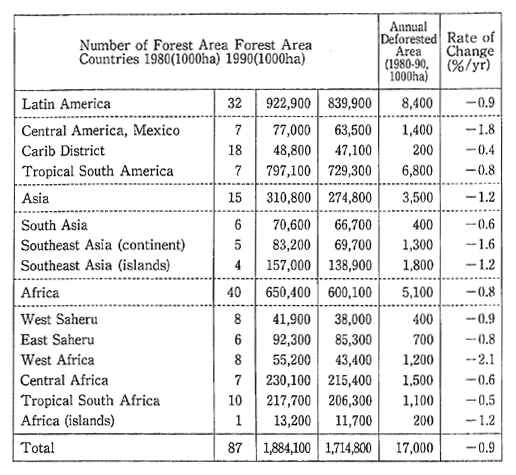
Source: Second Interim Report on the State of Tropical Forest" by Forest Resources Assessment 1990 Project, FAO
b. Soil
Soil is the foundation of economic activity such no agriculture and livestock farming. If soil conditions deteriorate, or if soil in deplet-ed, then not only does it become impossible to carry out these particular types of activity but our very way of life becomes threatened. In the Sahel region and many other places in Africa, so people are in poverty and lack alternative methods to secure fuel or increase harvests, over-cutting trees for firewood, overgrazing livestock, or shortening the migratory harvest cycle has resulted in soil degradation and loss and in land becoming arid. When people no longer have the strength to face the recurring droughts they become environmental refugees and flee to other regions or to cities. Soil degradation and loss can be seen every-where, and moreover, these problems do not end with eventual deser-tification. The wind can raise clouds of dust into the air; salt damage or alkalization can occur; and poor drainage of irrigation water can result in water logging. In high altitude regions such as the Himalayas or the plateaus of Ethiopia, soil that has lost its vegetation is being drastically eroded. In 1992 the UNEP gave a report entitled "Status of Desertifica-tion and Implementation of A Plan of Action to Combat Desertifica-tion" at a special session of the UNEP Governing Council. Based upon this report. we shall now take a look at the problem of soil deterioration resulting from arid land.
There are over 6.1 billion ha of arid land on the earth, accounting for close to 40 percent of the entire land surface. Out of this total area, 900 million ha are extremely dry land, or in other words, desert land. Part of the remaining 5.2 billion ha are in the process of desertification due to the human activity. Approximately one fifth of the world's population is dependent on these arid lands for its livelihood. According to a 1991 UNEP survey. 69.0 percent of the agricultural land in arid areas (3.56 billion ha) is showing effects of drying. This breaks down to 43.15 million ha of irrigated land (approximately 30 percent of all total irrigated land) which is deteriorating, and 2l5.56 million ha of rainfed land (47 percent of such land), and 3.33 billion ha of rangeland (73 percent of such land) which are undergoing desertification. By region, and in decreasing order of proportion of land that is drying, North America is first, followed by Africa, and then South America. In terms of area, Asia is first, followed by Africa (Figure 1-2-8).
Soil degradation has affected 1.14 billion ha, or 18.3 percent of the total arid land area (including extremely dry land). The most common form of soil damage is soil loss due to run-off from rain fall. This is followed by topsoil carried away by the wind, chemical deterioration through salt damage or alkalization, and physical damage by excessive irrigation and poor run-off. The continents which have suffered the largest area of damage are Asia, followed by Africa, and then Europe. In terms of the proportion of arid land that has suffered soil deteriora-tion, Africa has the most serious conditions by far, with 81.1 percent of its dry land area affected.
Fig. 1-2-8 World Drylands
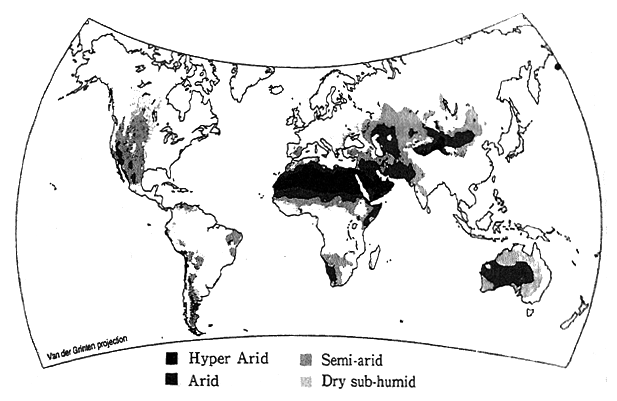
1-2-2 Wildlife
(1) Wildlife
a. Distribution of wildlife in Japan
The Japanese natural environment reflects a wide variety of climatic, geographical and topographical factors. In accordance with the wide variety of ecosystems there is also profuse variety of wildlife,
"Wildlife" has an extremely broad definition that denotes all species of animals and plants that exist on the earth except the domes-ticated species and breeds. The very existence of these various species and subspecies is a precious sources of information that helps us under-stand the history of evolution. As constituent elements of their eco-system, they are part of a cycle of material, and form a necessary link in the food chain. Their diversity reflects their flexible response to external changes in their environment. Human beings coexist with and utilize these wild animals in various ways: They may constitute sources of food, materials for a wide variety of tools and instruments, or objects of science, education, recreation, or art. But above all, each species represents a unique, constituent part of the ecosystem.
Once a species has been extinct, we have no means by which to recreate it. In a variety of ways, mankind has captured, utilized, and in the case of dangerous pests, exterminated wildlife. When such human activities lead to indiscriminate hunting and fishing, or when natural ecosystems are destroyed as a result of expanding social and economic human activities, the populations of these species decrease, and in some case, the entire species will be threatened with extinction. Preventing the extinction of wild species is an urgent problem both from the perspective of conserving the ecosystem, as well as protecting the species themselves.
The Japanese Environment Agency initiated a study of threatened flora and fauna in Japan. Based on the results of this study, the Agency published "Threatened Wildlife of Japan-The Red Data Book" in 1991. According to this survey, the following numbers of species and subspecies in each taxonomical group are native to Japan: 188 species of mammals, 665 species of birds, 87 species of reptiles, 59 species of amphibians, 200 species of fresh water fish, 29,000species of insects, l92species of spiders and other arachnids, 824 species of crusta-ceans, and 4,040 species of other invertebrates.
Based upon the degree of threat to their survival, these species are classified as "Endangered", taxa in danger of extinction and whose survival is unlikely if the casual factors continue operating, "Vulner-able", taxa believed like to move into "Endangered" category in the near future if the casual factors continue operating, "Rare", taxa with small populations that are not at present "Endangered" or "Vulnerable" but are at risk. There are 110 "Endangered" species including mammals such as the "Japanese otter" and "Iriomote wildcat", birds such as "short-tailed albatross", "Japanese crane", "Preyer's woodpecker", and "Blakiston's Fish-owl", amphibians or reptiles such as the "Hokuriku salamander", and "chrysanthemum swamp snake", and fresh water fish such as the "Ryukyu ayu", "Miyako bitterling" and "Musashi tomiyo". There are 114 "Vulnerable" species such as the "Hawker's least shrew", "peregrine", Japanese marsh warbler", "Yellow-marginated box tur-tle", "Ishiwaka frog", and "Itoh". There are 415 "Rare" species such as "Erabu large bat", "dormouse", "sea otter", "Common green turtle", and "Yuufutsu yatsume". There are also 22 species which have already become extinct, including the "Japanese wolf", "Japanese sea lion", "Rufous night heron", and "Minami tomiyo". If we sum up these "Extinct", "Endangered", "Vulnerable", and "Rare" species, we can see that there are 55 species of mammals, 132 species of birds, 16 species of reptiles, 14 species of amphibians, 41 species of fresh water fish, 206 species of insects, and 127 species of crustaceans. Excluding the insect class, which comprises an enormous number of species, the remaining species and subspecies identified above account for more than 15.0 percent of the total number of species (Table 1-2-9).
Table 1-2-9 Numbers of Endangered Wildlife Species in Japan
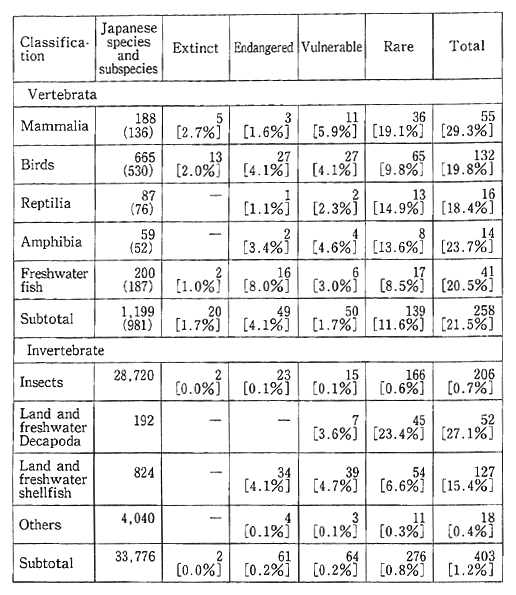
Sources: the Survey for Selection of Flora and Fauna Species Requiring Emergency Protection: 1992, Environment Agency
Note: The figures include these of species and subspecies. The figures in parenth-eses represent those of species. The numbers of Japanese species and sub-species are those of scientifically named ones.
Extinct: Species or subspecies considered to have already become extinct in Japan.
Endangered: Species sr subspecies on the verge of extinction.
Vulnerable: Species or subspecies with an increasing danger of extinction.
Rare: Species or subspecies for whose survival infrastructure is vulnerable.
We can ascertain the distribution of the major types of the animals in Japan in the 1730s by examining records compiled during the Edo Period. According to those records, species such as the wolf, river otter, Japanese sea lion, and white stork, which are now either extinct or threatened with extinction, were widely observed in 1730's. Other groups of animals such as the Japanese monkey, the Asian black bear, and the Japanese deer, are thought to have disappeared in some areas. As a result of changes to the riparian environment, it has been observed that many species of birds (such as the duck or the goose) have changed their migratory paths and destinations.
The main factors behind the extinction or threatened extinction of these animals include hunting, changes in habitats due to increasing industrial activities or expanding residential areas, altered river envi-ronments, and deteriorated water quality. As a result, populations have been reduced, and habitats have deteriorated or disappeared entirely. These are very harsh conditions for natural habitats in Japan.
According to the study of threatened flora and fauna, the follow-ing numbers and types of plant species are native to in Japan: 8,118 species of vascular plants, 1,850 species of seaweed, 1,516 species of mosses, 535 species of liverworts, 2,295 species of lichens, and 10,000 species of fungi (including subspecies, varieties, strains, and substrains). On the other hand, according to the report "The State of Plant Species in Need of Protection in Japan" prepared by the Nature Conservation Society of Japan (NACS-J) and the World Wide Fund for Nature -Japan (WWF-Japan), there are 147 species that are endangered, 677 species that are vulnerable, and another 36 species that are threatened in some extent although their precise conditions are not clear. Names of rare species are not made public in order to avoid their being picked as valuable specimens. 36 species are already extinct. This means that 16. 8 percent of the total 5,300 species of wild plants in Japan are endan-gered (Table 1-2-10). The main reasons that many plants are threatened with extinction are the deterioration or disappearance of their habitats as a result of industrial or residential development, and indiscriminate gathering of plants and shrubs for the purpose of stocking private gardens and of sale. Damage to their natural habitats is not limited to physical destruction but also includes deterioration of the surrounding environments such as destruction of ground water veins. This shows that there is insufficient consideration given to the effect of certain types of activity upon the plant habitat and ecosystem.
Table 1-2-10 Number of Endangered Plants
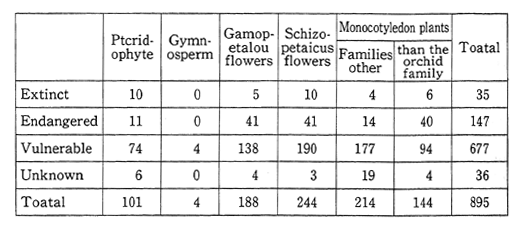
Source: "Present Situation of Important Plant Species in Japan Important to Protect, 1988" edited by the Species Subcommittee of the Study Committed on Important Plant Species and Communities in Japan to Protect published by the Japan Nature Conservation Association (NACS-J) and the Japan Committee of the Worldwide Fund for Nature (WWF-J)
Japan occupies a very important position as a migratory ground for birds from Siberia and other places. Since migratory birds pass freely between countries, it is important for every country in their path to take the appropriate measures to protect their habitat. Even if only one country fails to protect their environment, then the number of these birds will decrease. For this reason the protection of migratory birds is an international responsibility and Japan has entered agreements with countries such as United States, China, Australia and Russia.
Approximately 75 percent of the birds observed in Japan are migratory. According to the Goose and Ducks Survey carried out in Japan in January 1992, the total number of ducks and geese observed was 1.968 million, the largest number on record (Figure 1-2-9). Of these, 96.30 percent were ducks, 2.56 percent were swans, and 1.14 percent were geese. The swans, which numbered 50,357 and included 4 different species, were observed at 397 location in 27 prefectures. Most of these places were in the Tohoku region, Niigata prefecture, and Hokkaido. There were 22,783 geese, representing 6 species observed at 67 locations in 21 prefectures. Most of the geese were observed in Miyagi and Niigata prefectures. Most numerous were the ducks, of which 1,896,119 birds of 32 species were observed mostly in Niigata, Aichi, Chiba, and Ibaragi prefectures and Tokyo.
Fig. 1-2-9 Total Number of Birds in Wild Goose and Duck Families Observed in Japan
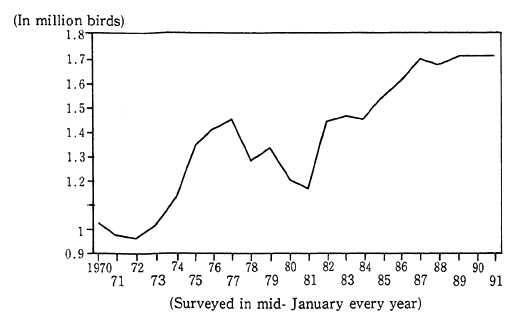
Source Environment Agency
Path tracing surveys utilizing satellites and bird banding surveys are also carried out in order to contribute to international cooperation for the preservation of migratory birds and their resting grounds through a better understanding of migratory routes. As a result of this work, resting grounds for birds such as the Latham's snipe from Australia, or the swallow from Southeast Asia have been made clear. Migratory routes of the white-necked and the hooded cranes have been discovered to Korea and China, and of the whistling swan to Siberia. Further surveys and research are being carried out through interna-tional agreements to preserve birds.
b. Global distribution of wildlife
There is a relatively good understanding of the numbers of species of plants and vertebrate animals world wide. There is, however, much less knowledge about other toxonomical groups of wildlife, espe-cially insects, and the numbers of species can only be estimated. The total number of species on the earth may range anywhere from 5 million to 50 million. Efforts to date have only resulted in the cataloging of approximately 1.4 million species.
The majority of these species inhabit in the tropical forests. These tropical forests account for no more than 7 percent of the earth' s entire land area, but is said that it provides habitat for more than half of the world's species of plants and animals.
Regarding known species, the countries that have a large number of mammals, birds, amphibians, reptiles, Papilionidae butterflies, and angiosperms, are shown in Table 1-2-11. Countries with tropical forests such as Indonesia, Malaysia, Zaire, and all of the countries in South America, are prominent among this group. Those with a large number of different habitats and many unique species, are referred to as "mega-diversity countries".
Table 1-2-11 Countries with Many Wildlife Species
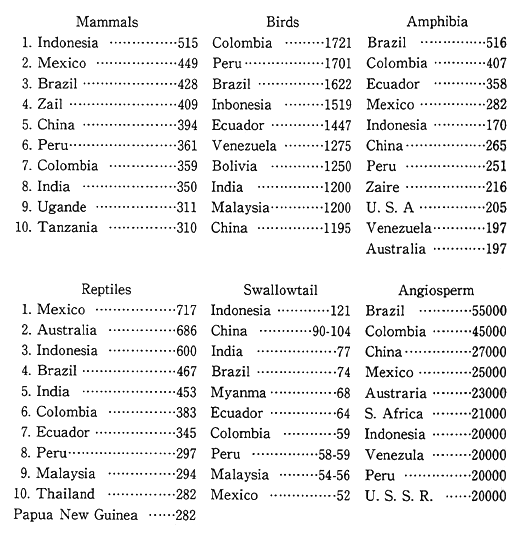
Sources: "Conserving World Biodiversity' IUCN. WRI, CL, WWF-U. S. A. World Bank
About 60 to 70 percent of the world's species are said to exist in the twelve mega-diversity countries of Brazil, Colombia, Ecuador, Peru, Mexico, Zaire, Madagascar, Australia, China, India, Indonesia and Malaysia. In particular, Brazil, Colombia, Indonesia, and Mexico have a large number of species, while Australia and Madagas-car have many endemic species. Some countries such as Brazil and China, are very large and therefore have many different species, and other countries such as Ecuador, Madagascar and Malaysia have a small area but are rich in species diversity owing to factors such as topography. These countries' individual efforts are insufficient in order to preserve their abundant species. They need international cooperation.
This abundance of species is rapidly being lost as a result of the destruction of their habitat. The "1988 IUCN Red List of Threatened Animals" describes the state of all species threatened with extinction. According to that list, 19,078 species of plants, 2,125 species of inverte-brates, and 2,464 species of vertebrates are either facing extinction or only existed in small numbers. Most of these species are endangered as a result of the near destruction of their habitats. We must also not forget, that in addition to those species we know about, there are many others about which we have no knowledge, that are either already extinct or facing extinction.
(2) State of wildlife resources
Human beings have hunted animals and utilized them as a food resource since prehistoric times. Man is a predator within his eco-system. Even today, fishing and hunting activities continue through which man directly harvests the bounties of nature. Human beings threaten the foundations of the ecosystem not only through pollution, but also through their impact as predators. We shall examine fishing and hunting from this perspective.
a. Marine resources
The people of Japan have traditionally relied upon marine prod-ucts as a important source of protein. In the years following the Second World War, the volume of marine products harvested from the sea (excluding that from aquaculture) increased virtually every year. By 1982, the volume topped 10 million tons, in 1984 it reached a record 11. 5 million tons, and the 11 millionton level continued until 1988. How-ever the level began to drop the following two years, reaching only 9.57 million tons in 1990. Catches of the main, and largest volume food fish are decreasing. Catches of pollaks, mackerel, tuna and marlin have been declined for several years, and catches of sardines and bonito have declined for two years (Table 1-2-12). Fish resources in the seas around Japan, especially that of bottom fishes, show a tendency to deteriorate and it is feared that resources of sardine are also decreasing. This resource deterioration is said to be caused by overly effective fishing methods like high performance fishing boat.
FAO estimated the sustainable yield for each ocean area in the world. If these estimates are compared with actual catches taken from each area, then in the Northwest Pacific including the sea off Japan, the Southeast Pacific, the Mediterranean Sea, the Black Sea, and the East Indian Ocean, actual catches are beyond the estimated sustainable yields. Fishing in the Northeast and Central East Atlantic, and the Midwest, Northeast and Central East Pacific have reached estimated sustainable yields (Table 1-2-13). These data of sustainable yields are rough estimates because there are difficulties with making accurate scientific estimates of global fish stocks. It is possible that the sustaina-ble yield has increased because of development of new fishing grounds since the FAO's estimate. In addition, even according to the FAO's estimate, there are fishing grounds for which actual fish catch does not reach the estimated sustainable yield. Nevertheless, the world catch has increased 37.2 percent, from 75.69 million tons to 103.88 million tons, in the past ten years. It is growing more and more important to consider maintaining the stock of fish resources.
Table 1-2-12 Output of Sea-Surface Fisheries by Major Fish

Sources: Ministry of Agriculture, Forestry and Fishery
Note: Output from aquaculture is not included
Table 1-2-13 Annual Catch and Sustainable Yield of Regional Marine Fisheries
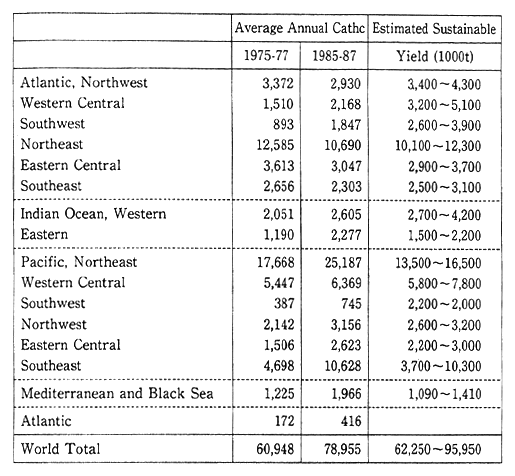
Source: FAO, "World Resource 1990-91"
There are discussions in many international meetings on the relation between fishery and protection of wildlife. At the Eighth Meeting of the Conference of the Parties to CITES held at Kyoto in March 1992, there were efforts to list the North Atlantic blue-fin tuna of North Atlantic Ocean as an endangered species and to restrict its international trade. In Europe and America etc., active anti-whaling campaigns were evident in which protecting whales is a symbol of nature protection. These are examples of such disputes.
Marine resources will continue to be highly valued in many countries both as an important supply of nutritional food and as a raw material for fertilizer. The sustainable utilization of these marine resources is therefore extremely important. Fishing is an industry that survives on the basis of utilizing renewable natural resources. It is important therefore to carry out rational management of fisheries on the basis of scientific data.
b. Hunting
The role of hunting is to keep the number of wild birds and animals within the carrying capacity of their natural habitats.
In Japan, a number of birds and animals have been designated as legal game. There are 30 species of birds such as mallard and pheasant, and 17 species of animals such as wild boar and deer which have been so designated. In 1989, approximately 3.62 million birds were caught of which 33.5 percent were turtledoves, and 24.1 percent were sparrows. In the same year, approximately 400,000 mammals were caught of which 58.7 percent were jackrabbits, 14.9 percent were wild boars, and 10.6 percent were raccoons (Table 1-2-14).
Prefectural governors and the Director-General of the Environ-ment Agency are also able to grant hunting permits for the purpose of exterminating harmful birds and animals. In 1989, 160,000 birds and 90, 000 animals were caught under governors' permits. Among the birds caught, most numerous were sparrows (40.6 percent), crows (21.8 per-cent), and domestic pigeons (12.0 percent). Among the mammals, most numerous were jackrabbits (61.3 percent), and wild boar (11.8 percent). In addition, birds and animals were taken under permits granted by the Director-General of the Environment Agency. Totals of takes by the special permits and through hunting amounted to 5.25 million birds and 495,000 other mammals in 1989.
The scale of hunting decreases each year. Until 1976, and in accordance with the rising level of personal incomes, the number of hunting licenses and the number of catches continued to increase.However in 1980, the number of catches (birds and animals) peaked at 8.4 million, and it has been rapidly decreasing since then. As indicated above, the number of birds and animals caught as game in 1989 fell to about 4.02 million. This is a result of the decrease in the hunting population itself which fell from 530,000 people in 1976 to 290,000 in 1989.
Table 1-2-14 Hunting and Capture
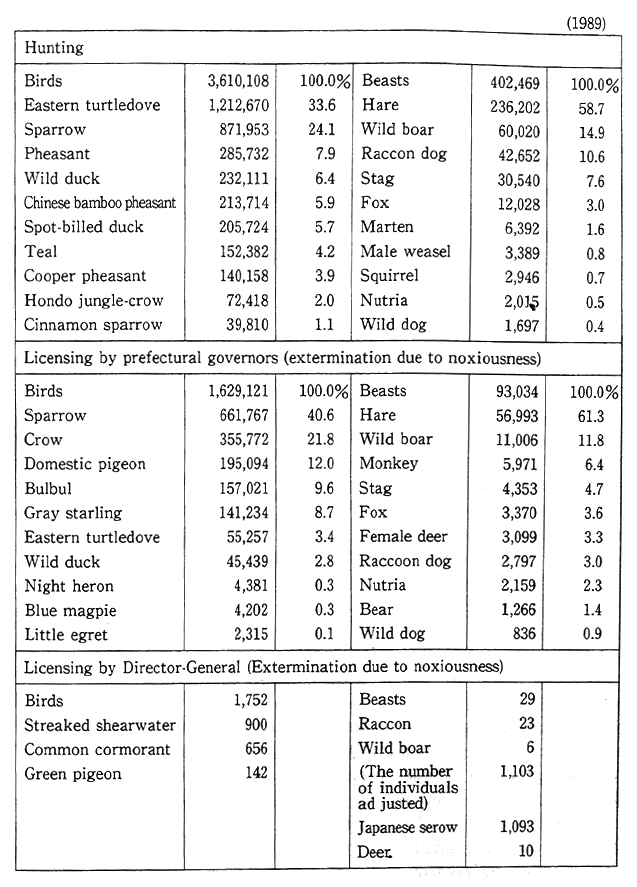
Source: Environment Agency
1-2-3 Other Natural Environment Resources
Hot springs
Japan is a country of numerous hot springs. Hot springs have long been utilized for rest and recuperation. In addition to their outstanding natural beauty, they are also highly valued as important recreational resort areas. In recent years, hot springs have received a great deal of attention as a result of the "hot spring boom" as well as for their potential for regional economic revitalization.
Present conditions show that the number of hot springs sites and actual hot springs origins are both increasing. However, among those that have been developed for use, the number of springs where the water comes out under its own pressure is unchanged, and those which require motor power to produce have increased. There is a notable increase in the number of springs with a water temperature of less than 42 Reasons are thought to include the fact that with the increase in the number of people utilizing hot springs, more effort is being made to force larger volumes of water out of the ground, and water is conse-quently being taken from deeper underground areas.
There has been a striking increase in the number of people utilizing hot springs. These numbers have been increasing steadily since 1984, and in 1990, a total of 140 million overnight guests registered at hot springs resorts (Figure 1-2-10). The Director of the Environment Agency is developing specially designated National Hot Spring Health Resorts in order to provide greater opportunities for people to find rest and recuperation in the midst of a rich natural environment. The 1.57 fold increase in utilization of these National Hot Spring Health Resort over the ten-year period from 1981 to 1990 has been particularly striking. This reflects a keen desire of the Japanese people to relax in nature.
Fig. 1-2-10 Increases in Aggregate Annual Number of Users of Lodging Facilities in Hot Springs
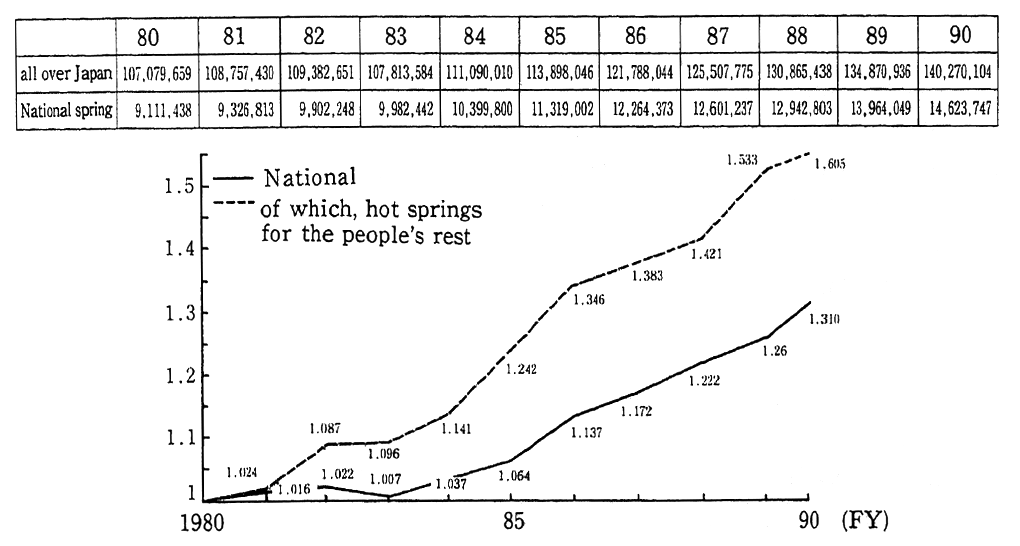
Annual increase rate of people using loding facilities (FY1980=1)
Source: Environment Agency
1-2-4 The Antarctic
In October 1991, a new framework for conservation of the antarc-tic environment was constructed in Madrid, with the conclusion of the "Protocol on the Conservation of the Antarctic Environment." Below, we shall take a closer look at the state of the environment there.
As specified in the Antarctic Treaty and other treaties, the Antarctic Zone is defined as the area lying below 60 degrees south of the equator with a total area of 52.50 million km2 of which 14.00 million km2 is land and 12.50 million km2 is sea. The average atmospheric temperature is minus 50 degree C, and 98 percent of the land area is covered with ice that is an average 2,450 meters thick. As a result of the harsh environmental conditions, as well as restrictions stipulated by the Antarctic Treaty, human activity on Antarctica is limited to research and study.
Even in this severe environment, ecosystems exist. On the tiny bits of land that appear between the cracks in the ice during the summer season, organisms consisting mainly of lichens live and construct an ecosystem. There are also some species of birds that have their breeding grounds on Antarctica. In addition to two types of seed plants known to exist there, the ecosystem supports fungus, lichens and mosses. Fifteen species of birds including penguins are known to make their nesting grounds in Antarctica. No mammals inhabitate the continent itself, although 6 species of seal and 10 species of whale inhabit the Antarctic Ocean. As many as 100 species of seabirds are known to exist iucluding 15 species that breed on the continent. There are also numerous species of fish and krill. In spite of the severe environmental conditions these organisms have managed to construct a unique and valuable ecosystem.
Antarctica, or the "science continent" as it is sometimes call also has tremendous value as a site for conducting meteorological observations and geophysical research. As mentioned above, research on the destruction of the ozone layer has been conducted on the basis of data collected there.
According to the Antarctic Treaty which limits human activity on Antarctica almost entirely to scientific research, the antarctic envi-ronment has so far managed to be preserved. However, in 1991 the moratorium on mining activities on Antarctica expired, and sightseeing has increased to the point where approximately 3000 people visit each year. How to handle the wastes generated from these observation bases is also becoming a problem. In view of this situation, the "Protocol on the Conservation of the Antarctic Environment" was adopted in October 1991 as part of the Antarctic Treaty, as a new framework for preserva-tion of the antarctic environment. This protocol seeks to protect the important natural environment and ecosystems of Antarctica as a place for scientific observation and research and as the only continent free from human exploitation.
Penguins on an island near the Showa Antarctic Base
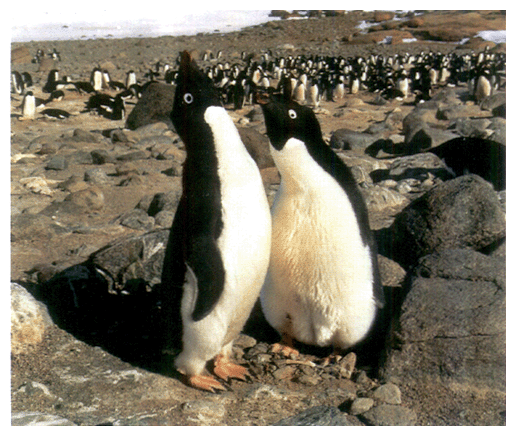
Long-armed Scarabaeid Beetle
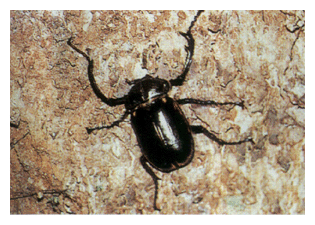
Blakiston's Fish-Owl (left, female; right, male)
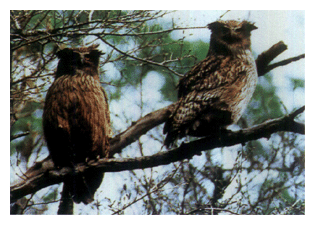
Distribution of CO2 Emissions (1986)
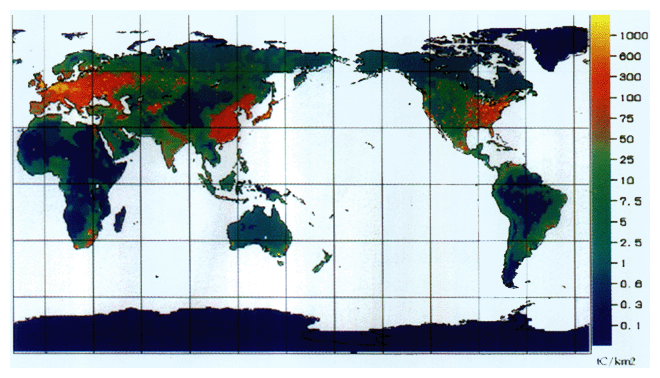
Distribution of CO2 Emissions (2100)
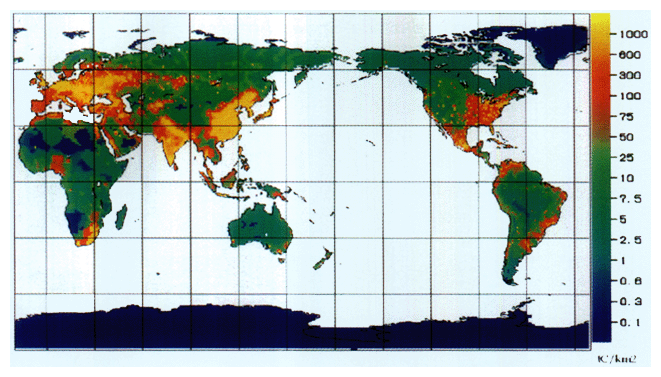
Source:National Institute for Environmental Studies and Kyoto University (Matsuoka)
Chapter2. Our Experiences Toward a Sustainable Society
As we have seen in Chapter 1, there are still many problems such as people being exposed to smoke that contain pollutants, but in addition to these, we are faced with a problem of another kind: that is, pollutants spread thinly throughout the environment are changing the character of the environment itself. Furthermore, we are increasingly faced with problems such as decrease in resources in the form of living things that support human living, destruction and loss of species, ecolog-ical systems, soil and water. With regard to these kinds of problems, we can state that we are now faced with deterioration of environment as "the stock." Just like people use the savings they built to prepare for the future to cover their livings costs today, so, we are depleting the global environment which is our stock, to meet the needs of the present generation. But undermining the environment in this way creates a grave impact on the lives of the people of future generations.
In particular, we are now confronted with increasingly serious problems such as the deterioration of the environment in developing countries that is so severe that waves of refugees are created; destruc-tion of wildlife which is suspected of being linked to pollution; strange climatic conditions that may be linked to increases in the green-house gases, and the drastic increases in wastes, which cause a real concern as to whether or not we will be able to dispose of them correctly. With the advent of these conditions, the question of whether it is possible for human society to sustain itself has become a truly serious question.
The "United Nations Conference on Environment and Develop-ment" (the Earth Summit) scheduled in Brazil in June 1992 represents a global effort to reach a consensus in concrete terms for creating a sustainable global community. While the approach and concept of "sustainability" has come to the attention of the general public only fairly recently, Japan has already had some useful experience in the course of the path that it has taken. In this chapter, we will look back upon Japan's experience in the light of "sustainability."
2-1 Environment and Sustainability
In this section, we will reflect upon why the demand for "sus-tainability" has become so prevalent.
2-1-1 Rising consciousness on the indispensable roles served by the environment
With the rising anxiety about the deterioration of the global environment as background, the awareness about the need to protect our environment has been growing rapidly. Let us begin by taking a look at the number of reports and articles related to environment in newspapers, as an indication of the level of concern. (Fig. 2-1-1)
Fig. 2-1-1 Number of News Items in Major Daily Newspapers
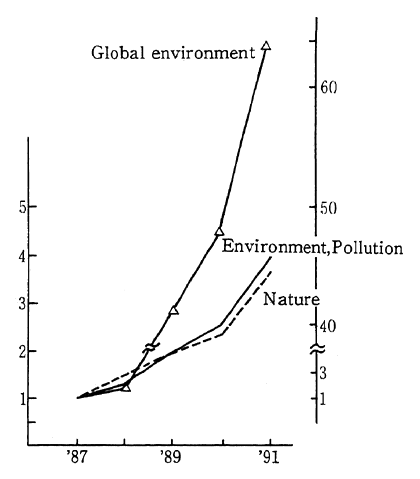
Note: 1. The numbers of news items in seven nationwide-circulated newspapers are indexed for each year with, 1987 at in The numbers of cases are loo-ked up in Nikkei Telecom. 2. See the left-hand axis for "environ-ment, pollution" and "nature" and the right-hand axis for "global envi-ronment."
We can infer that in the background of the growing concern about the environment is the fact that people have come to recognize how really crucial our environment is. According to the public opinion survey carried out in 1991 by the Prime Minister's Office, we find that people have very diverse views, ranging from spiritual reasons such as "Nature provides the human heart with peace and freshness," to more materialis-tic and utilitarian views such as "It is important for securing resources." (Table 2-1-1)
Table 2-1-1 Reasons for Favoring Nature Protection

Note Surveyed by the Prime Minister's Office. Answers of those who choose "protecting nature is most important thing for human to iive." or "protecting nature is to be carried out in accordance with human society.".(plural answer)
As we can see in the findings of this public opinion survey, the environment provides wide-ranging, diverse kinds of blessings to people, and we can describe the roles served by nature as diversified and multi-functional. That is, the environment that surrounds us not only provides the resources and energy needed for the activity of human beings and other living things, but also provides us with spiritual fulfill-ment and peace; and it is even capable of absorbing, and assimilating, wastes that humans and other living things produce. By way of analogy, we can say that the environment is the life-sustaining mechanism (sys-tem) of the spaceship "Earth." We can say this because just like life-sustaining equipment, the global environment produces what are neces-sary for humankind, and treats and disposes of waste. Now, in the case of life sustaining equipment for a spaceship, appropriate equipment is selected depending upon the expected number of hours of use, the designed weight and load capacity (Fig. 2-1-2). In the case of the Earth, it is not enough for life to be sustained merely for a limited time period, but it needs to be sustained from one generation to another, and handed down to our descendants. The life sustaining "equipment" for the Earth cannot be replaced. Given this reality, as activities of humankind expand (and intensify), some concerns naturally arise as to whether or not the environment can sustain the existence and lives of today's generation, and still continue to serve the roles expected of it for future generations, perpetually. In short, we must take up the issue of "sus tainability" as a truly vital question.
Fig. 2-1-2 Usable period and weight of different kinds of life maintenance facilities
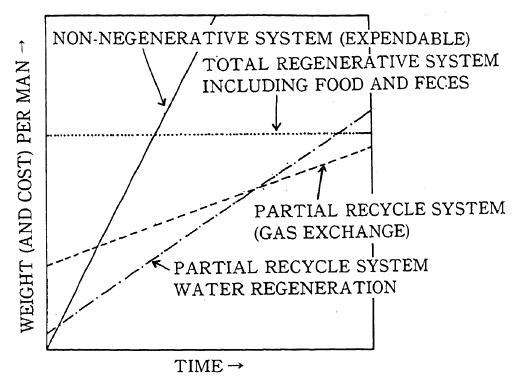
(SOURCE) G, DENNIS COOKE, "ECOLOGY OF SPACE TRAVEL", chapter 20. FOUNDAMENTALS OF ECOLOGY (1971, E. P. ODAM)
2-1-2 Forecasting the Future of the Global Environment
If today's trend of expanding human activity continues, will the earth be able to support it? More, will the earth be able to take in and treat all the wastes that human activity produces? On this point, some significant research has been carried out in the past including "The Limits of Growth," the report presented by the Club of Rome in 1971, and the "Earth in the Year 2000" made public in 1980. A summary of these forecasts is presented in the table below. (Table 2-1-2)
Have the points made in these past forecast lost their validity and applicability for the situation we face today?
According to the projections made by the United Nations, the world population will grow to about 6,254 billion by the year 2000, and 8.5 billion by 2025, which is roughly 1.6 times the population in 1990. Later, the world population will reach 10.0 billion, and 11.6 billion by 2150, after which the population level will remain at about the same level. In terms of the relative population increase of the developed countries and developing countries, the projections show that about 96% of the population increase will occur in developing countries. In many developing countries, there are already serious shortages of food, water, and health and sanitary services, and so it is feared that such sharp population increases will cause the level of well being and services in these countries to deteriorate further.
Table 2-1-2 Comparison of Future Projections and Present Situation of the Earth in 2000
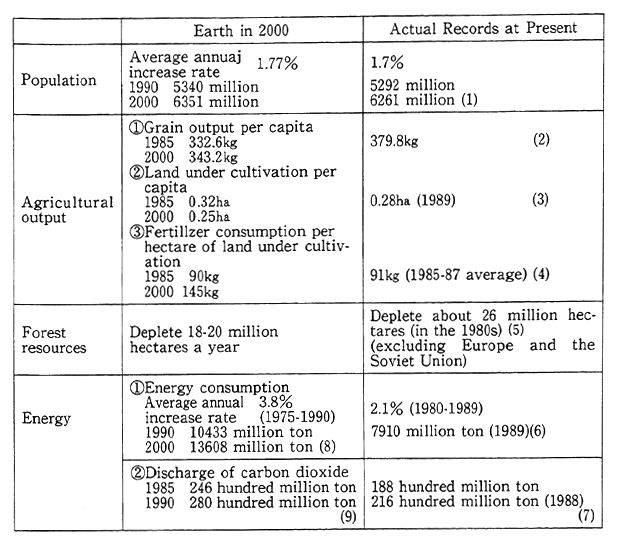
(1) The State of World Population, 1991
(2) The State of Food and Agriculture Illustrated Book on States of Countries in the World
(3), (4) and (5) World Resource 1900-91
(6) The incresse rates ; World Development Report 1991, World Bank :
(7) IPCC Report. 1990
(8) The original unit of BUT is converted in terms of oil.
(9) The original unit of short ton is converted in terms of metric ton.
When we look at the food situation, while the total production volume itself is expected to increase, the supply of food calories per capita in developing countries overall is expected to decrease: that is, the number of people who cannot get even 1.4BMR (1.4 times the basal metabolic rate -BMR-or about 1520 cab, ries) is expected to increase to about 530 million by the year 2000. The shortage of grain was about 70 million tons in the early 1980's, but it is expected to climb to 110 million tons by 2000. We should note, moreover, that this projection is based upon an assumption that the grain production will increase. Due to improvement in fool production, the yield per unit of area (contributing rate 63%) and increases in the cultivated area (contributing rate 22%), the harvest volume is expected to increase by 358 million tons (or 45%) from the 1986 level. The total increase in cultivated area is projected as 83 million ha, but it should be pointed out this is a net increase, and so, the actual size of new cultivated areas must be larger. For, while virgin areas are turned into farming area, old, deteriorated farm land is being abandoned. In this connection, according to one set of statistics, each year about 7 to 8 million ha is being lost due to washing out and erosion of soil, and 1.5 million ha is lost due to flooding, accumulation of salts and increased alkalization. 83% of the increase in land area under cultivation is expected be in Latin America and Sub-Sahara Africa. This implies the expansion of cultivated land into the tropical forest areas. In this connection, according to the FAG (Food and Agricultural Organization), each year about 17 million ha of tropical forests are already being lost today due to expansion of agricultural land and cutting down of trees for fuel use etc. Unless appropriate measures are devised and taken, there will be a serious deterioration of the natural resources overall through the reduction of tropical forests. And in relation to the global warming process, forests have the function of absorbing carbon dioxide in the atmosphere and storing it in their trunks, branches, roots, and soil, and so, as forests are lost, this huge capability to absorb and consolidate carbon dioxide will be lost, and in addition, the stored carbon dioxide will be discharged into the atmo-sphere. According to the 1990 report of the Intergovernment Panel on Climactic Change (IPCC), such discharge volume was estimated to be 1. 7 billion tons per year (1985). As the pressures of population increase and efforts are made to improve the food situation further, the pressures on the environment are likely to increase even beyond forecasted levels.
Now, let us look at the forecast on the discharge volume of carbon dioxide made with the use of the simulation model developed under the leadership of the National Institute for Environmental Studies. According to the results of the simulation, unless some special steps are taken, the discharge volume of carbon dioxide in the year 2025 will be between 1.4 to 2.4 times the level prevailing in 1985. By 2100, it will be between 2 to 7 times the level in 1985. Because of this increase in the discharge volume, the carbon dioxide concentration in the atmo-sphere will increase, and the temperature will rise by three to five degrees by end of the next century. (Fig. 2-1-3)
Fig. 2-1-3 Projections by Simulation
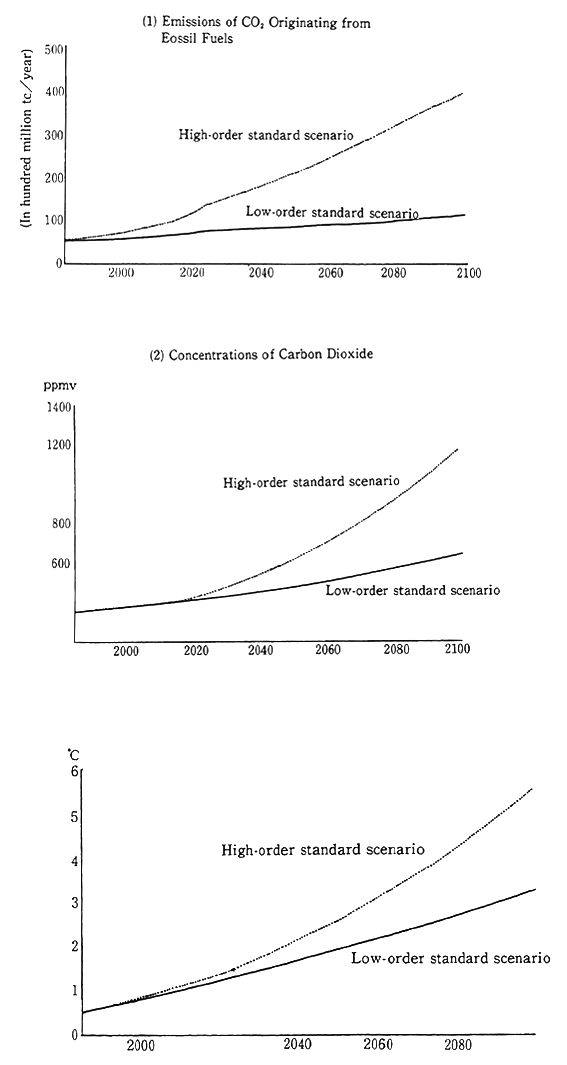
Note:1. Population Scenario
(1) Medium-order scenario : Medium-order projection by the World Bank in 1990 (1,130 million people in 2100).
(2) High-order scenario High-order projection by the U. S. Census Bureau (1,350 million people in 2100). 2. Economic-Growth Scenario
(3) Low-order scenario A drop of 20% in the GNP growth rate in the IPCC-quoted scenario.
(4) High-order scenario A rise of 20% in the GNP growth rate in the IPCC-quoted scenario. 3. Scenario for Rates of Improvements in Final Energy Demand Efficiency
(5) Higher-efficiency scenario: Hypothesis used as the basis for the scenario of a rapidly changing society by the U. S. EPA.
(6) Lower-efficiency scenario : Hypothesis used as the basis for the scenario of a moderately changing society by the U. S. EPA.
4. Hase hypothesis for simulation Low-order standard scenario
= (1) + (3) +(5)
Cigh-order standard scenario
= (2) + (4) + (6)
Incidentally, according to the report of IPCC referred to above, this global warming will bring with it impacts in a diverse range of fields.
As the temperature rises rapidly, plant life will be affected, and forests in semi-arid areas will be reduced. Since climate overall, and not just the temperature, will undergo large changes, it is anticipated that a number of animals and plants in terrestrial ecological systems will not be able to adapt to these changes, and these species will face extinction. Precipitation volume is expected to increase in most areas, but so will the volume of evaporation. Due to these changes in precipitation pat-terns, the possibilities for water use may expand in marginal areas such as the Sahel region in Africa. Also, in the middle-latitude and high-latitude regions, snowfall will decrease in terms of distribution areas and time periods, and permanently frozen soil in the northern hemi-sphere will decrease sharply. Topography will become unstable, with increased erosion and landslides, etc. Sea levels are expected to rise due to additional sea water and melting of polar land ice. These climactic changes will bring about a severe impact initially on agriculture which depends heavily on the natural environment. The total agricultural production in the grain belt in the southern region of the United States and Western Europe will decline, and in those areas such as Africa's Sahel region and Brazil that are especially susceptible to environmental changes, there will be severe impacts in the form of decreased produc-tion and other effects. The rise in the seas level will make it impossible for people to inhabit a number of island nations; it will threaten low-lands in urban areas, cause sea water to infiltrate upstream in rivers, which, in turn, will compel tens of millions of people to move out of their communities. The increase in precipitation will lead to an increase in the numbers and severity of natural disasters such as flooding of rivers, with grave effects for both agriculture and urban living. Also, there is a possibility that due to the increase in precipitation and temperature, disease-causing germs and viruses will move to high-latitude areas, which will have a significant negative impact on health. It is anticipated that such effects will be especially large in major urban centers where sanitary conditions can deteriorate quickly.
In this way, even though reports such as "The Limits of Growth" and "The Earth in the Year 2000" have issued clear warnings based upon huge amounts of research data, it can be said that humankind continues to follow the path of destroying their own foundation for survival.
Japan is dependent on overseas sources for food and most of the products and resources of primary industries. When we look at Japan' s share of world imports of such goods and resources, we find that it accounts for 13.4% of all petroleum imports (1988), 11.7% of grain imports (1989), and 26.3% of lumber (1989). These figures show an extremely high level of dependence on overseas resources. So, when conditions deteriorate for these primary industry products, that will exert a big impact on Japan as well (even if it is occurring outside of Japan). For example, in 1983, when the U. S. corn crop (the raw material for concentrated animal feed) declined drastically due to drought, that brought about sharp increases in product prices, and created a much confusion in Japan.
2-1-3 Environment and Sustainability
In order to overcome the crisis that humankind faces regard,ing "sustainability," and to ensure lasting development of human society, the concept of "sustainable development has begun to be used at various international conferences as a key concept related to global environ-mental issues.
With regard to "sustainability," when we look at it historically, the question of sustainable utilization of resources was raised first out of discussion of the theory of "maximum sustainable production vol-ume"in relation to fisheries. It arose out of a critical self-reflection of excessive competition to overcatch marine and fishery resources. Here, the concept of "sustainability" was based upon the awareness that there is a certain physical limit for catching specific types of fish and other living things that are renewable; that is, only the net reproduced volume created out of a certain level of stock, can be used rationally. If more is caught and consumed, then the stock itself declines, which, in turn, will invite the depletion of the resources in question. This realization became the premise for the discussion of "sustainability." To be sure, there are certain problematic aspects with the application of this con-cept in concrete terms: It is, for example, difficult to assess scientifically the maximum sustainable production level, and, for another, the ques-tion of how the use of the specific living things under discussion will impact on the ecological system overall, including other living resources. Be that as it may, the concept does provide a useful tool for approaching the discussion of how we should manage the global environ-ment. The figure we present next deals with the example of a fish called the guppy, and it shows the relationship between the stock volume and the sustainable production volume (catch), which was obtained experi-mentally. (Fig. 2-1-4)
One factor which gave rise to worldwide anxiety and concern about whether or not today's relationship between the global environ-ment and activity of humans can be sustained for a long period of time, was the issuing of reports such as "The Limits of Growth" and "The Earth in the Year 2000" by the Club of Rome, and other bodies. As these concerns about the future of humankind became deeper and more widespread, an increasing number of proposals were made for a policy direction that will alleviate the grounds of these concerns. This is what the idea and approach of "sustainable development" is all about. This term, "sustainable development" was used in a document circulated worldwide for the first time called "World Conservation Strategy" which was drawn up in 1980 by the International Union for Conser vation of Nature and Natural Resources (IUCN) under the cooperation of the United Nations Environment Programme (UNEP) and the Worldwide Fund for Nature (WWF).
Fig. 2-1-4 Relation between biomass and output of guppies
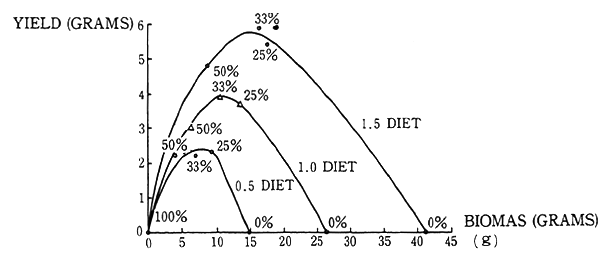
Note Biomass and yield in test population of guppy exploited at different rates at three different diet levels. 1971, E. P. ODUM (After Silliman, 1969)
Further, the term "sustainable development" became popularly accepted in the report "Our Common Future" issued in 1987, by the World Committee on Environment and Development (WCED) which was established upon Japan's proposal under the United Nations Envi-ronment Programme (UNEP). This report was received very highly by the international community, and in 1988, a resolution was passed by the U. N. (42/187) which welcomed this report and which affirmed that the concept of "sustainable development" serve as the central guiding principle for the United Nations, various national governments, and organizations, organs and business enterprises in the private sector. At the G-7 Economic Summit which was held in Toronto in the same year, the report was evaluated very highly as well.
According to this report by WCED, the concept of "sustain,able development" is defined as "development which is carried out to satisfy the needs of the present generation in such ways that it does not undermine the capability to fulfill the needs of the future generations." As such this concept is based upon the following two ideas.
(1) Unless poverty is alleviated, the process of environmental destruction will accelerate.
(2) From a long-term perspective, there are limitations in the capabil-ity of the global environment to nurture and support humankind.
From the first point, it follows that "development" should be carried out so that the basic needs of impoverished people throughout the world can be met. Otherwise, poverty becomes a big factor in the destruction of the environment. Impoverished persons are forced to cut down trees and forests in order to secure farm land and fuel, they may be led to overgraze their livestock, and use the environmental resources beyond the renewable capability, out of the sheer need to survive. This excessive consumption of environmental resources, brings about further impoverishment, and it becomes a vicious cycle. The concept of develop-ment as used here is a broader concept than just a conventional income index, etc. (such as GNP). It includes qualitative improvement of living as well as quantitative economic expansion, and so, it must give close considerations to a variety of factors such as fair distribution of income, education, health, clean air and water, protection of nature's beauty, etc. It must take into consideration a broad range of needs and welfare that are tied to values other than those in the purely economic realm.
With regard to the second point, it regards prevention of environ-mental pollution as a matter of course, and holds that utilization of resources in the "development" process must be within the scope of the environment's ability to accept and tolerate from the viewpoint of securing fairness between the needs of the present generation, on one hand, and the needs of future generations on the other. For example, with regard to renewable/reproducible resources such as forests and fish and other marine products, they must be used at a level which will not reduce the stock to be handed down to future generations. As for non-renewable resources such as petroleum and minerals, technologies for the use of substitution materials must be developed. Development and consumption of these resources should be carried out at an appropri-ate, moderate speed so that substitutes can be developed adequately and their use disseminated widely.
In relation to the approach of "sustainable development" and the concrete measures for its realization, a number of problems such as the concept of fairness, and especially, the concrete meaning of "fairness" as it applies to the relationship among different generations, and the question of how to evaluate the quality and quantity of the environmen-tal resources that we should leave to the future generations need to be examined. These points will be looked at more closely in Chapter 4. But what is important about this concept and approach of thinking is, first, myopic kinds of economic activities that are intended to escape poverty end up destroying the environment, and are harmful for the economy itself. Secondly, it points out that the relatively affluent living enjoyed by people in developed countries is not based upon assumption of the correct costs that are necessary for maintaining such life-style and level of living; rather, the costs are in a sense "charged" to the future generations. That this concept of "sustainable development" called people's attention to this reality is very significant. Furthermore, it made a solid and straightforward appeal on how important it is for the generations who live today, especially those in the developed countries who lead relatively affluent lives, to give consideration to securing the foundation for future generations, and to exercise the necessary self-restraint. Unlike simple "end-of-the world" type pessimism, this concept serves to give encouragement to people. We are called upon to make vital use of this concept of "sustainability" in formulating and im-plementing environmental policies, and to add more and more substance to it. In what follows, based upon the actual experiences and examples from Japan itself, and from cases that Japan has been involved in deeply, we will see to what extent we have succeeded in eliminating short-sighted pursuit of economic gains that bring about environmental destruction, and how much we have been able to protect the environ-mental stock which ought to be handed down to future generations.
2-2 Japan's Bitter Experiences of Sacrificing Sustainability
To gain a better understanding of the concept of "sustainable development" and add content to it, it helps to look at it from the opposite perspective and think of what kinds of development are not sustainable. In this section, we would like to explore relationships between development and sustainability as they existed in the course of Japan's experience.
2-2-1 Damage from industrial pollution such as Minamata Disease
Modernization of Japan's industries began in earnest in the second half of the 19th century, and economic development was pushed forward. In the early years of Meiji (1880's) serious damage from industrial pollution already began to take place such as poisoning from toxic metals from Ashio copper mines, and by 1910's, smoke and soot from factories of all types were becoming serious problems in large cities such as Tokyo and Osaka. In the post World War II years, these types of pollution became a problem in other parts of Japan.
In the postwar period of economic recovery and in the period of rapid economic growth in late 1950's and 1960's, top priority was placed upon expanding the economy; it was the society's goal on which people were united overall. Within this kind of social situation, business enter-prises pursued economic efficiency and gains in a more-or-less single-minded way. However, all of this also meant that there was not much awareness about the environmental pollution which was being created through this productive activity, and hardly any consciousness existed about devising and implementing preventive measures unless some mandatory controls were put in effect. Similarly there was scant atten-tion and consideration given to the effects exerted upon the environ-ment by the technologies that the company was using or the new technologies that the company was about to adopt, nor about how the company's products would influence the environment when they were consumed or disposed as wastes after use. In this kind of situation, a number of industrial pollution cases arose in the second half of the 1950' s and into the 1960's such as Minamata Disease, Niigata Minamata Disease, Yokkaichi Asthma, and Itai-itai Disease. Here, we shall take up the case of Minamata Disease, and review how business and indus-trial activities that lack adequate consideration of environmental aspects can cause extreme kinds of pollution, which, in turn, leads to tragic human health impacts and suffering, and reflect upon the grave negative consequences that such industrial pollution has brought upon the local communities and the polluting companies themselves.
(1) Human health damage
Minamata Disease is a disease in which the central nervous system is damaged by methylmercury compounds. Methyl-mercury, created as a by-product in the production process of acetaldehyde at Shin Nippon Chisso Hiryo Co., Ltd. (established in August 1908 as Nippon Chisso Hiryo Co., Ltd., later changed in 1965 to "Chisso") in Minamata City, was discharged into the Shiranui Sea. This bio-accumulated in fish and other organisms to high levels. As people in the area ate large amounts of such fish over a long period of time, it led to a new disease called Minamata Disease.
The production of acetaldehyde began in 1932. In May 1956, a report was received by Kumamoto Prefecture's Public Health Center in Minamata from a physician at the hospital affiliated with Chisso's Plant that patients were suffering from symptoms of a disorder of the nervous system resulting from an unknown cause. This was the first time that Minamata Disease was officially discovered. Minamata Disease often brings about grave damage and impediments on the human body, damaging the nerves, and causing impairment to sensory and motor ability. In the initial period after the discovery of Minamata Disease, there were a large number of patients who suffered from whole body convulsions, which led to death in some cases. Babies were born with serious birth defects such as mental disabilities and motion disabilities, and so, the disease led to human tragedies of major proportions.
While deciding to take a variety of measures to deal with these health damages, it took a long time to ascertain the actual causes. Furthermore, the legal basis for demanding the implementation of pollution prevention measure was inadequate, and there was as yet no clear-cut perspective on the question of compensation for damages caused by pollution. In the final analysis, it took a long time before appropriate and reliable counter measures and relief measures were fully put into effect.
The work to officially certify Minamata Disease patients based upon the Law Concerning Special Measures for the Relief of the Pollution-related Patients, etc., has been carried out. As of the end of December 1991, 1,767 persons in Kumamoto Prefecture and 485 persons in Kagoshima Prefecture have been certified as Minamata Disease patients. In addition, there are an additional 2,439 persons in Kumamoto and 292 persons in Kagoshima Prefecture who feel that they may be suffering from Minamata Disease and have applied to be certified. (Of this total, about one half are persons who have made such an application in the past and whose application has been rejected.) Under this system of certification and compensation, a cumulative total of about 90.8 billion yen has been made by Chisso to those who have been certified as Minamata Disease patients by the end of March 1991, which is an equivalent of about 120 billion yen in today's prices (on the basis of adjustment by the price levels in each year). Today, more than 3 billion yen is paid each year as compensation. While it is not entirely accurate to judge the magnitude of the damage by the amount of the compensa-tion amount, we can get a sense of how extensive the damage from Minamata Disease has been from the sheer amount of compensation.
During the past several years, the work of certification for the remaining applicants has been encouraged in a steady manner, and the number of unresolved cases has been declining gradually since 1986, but there are a considerable number of applications and repeated applica-tions pending. Some of the applicants refuse to be examined, and assessment of some patients is made difficult by their old age. Other unexamined patients have died, and yet other patients cannot be examined because they are bedridden, etc., and so, with all of this, there are still a large number of applicants whose applications for certifica-tion have not yet been disposed of. Similarly, there are more persons who live with anxieties that they may be suffering from Minamata Disease, and there have been various kinds of suits demanding certifica-tion as patients, and so Minamata Disease has given risen to all kinds of social conflicts.
In response to this situation, the Environment Agency posed the issue of the proper kind of overall measures and policy toward these problems to the Central Council for Environmental Pollution Control, and in November 1991, the Council presented its recommendation "The Proper Role of Measures for Minamata Disease in the Future." In the report, the Council recommended a health management program be instituted in which medical screening and examination be given to all the residents who may have been exposed to methyl-mercury, that a medical care and support program be implemented for those who are not certified as Minamata Disease but who have numbness or tingling in the limbs so that they are provided with medical care expenses and a medical care allowance, and that in addition, it is necessary to continue to move forward with the certification work and with research and investigation. Based upon this Recommendation, the Environment Agency has been working for implementation of an overall policy. In this way, even thirty-five years after its official discovery, the problems created by Minamata Disease are still with us as an important issue.
(2) The cost of the program to compensate for damage to the fisheries industry and for removal of the accumulated pollutants
Minamata Bay was once a very good fishing ground. The impact of industrial effluent from Chisso first appeared as damage to the fisheries industry in the form of reduced catch of fish. Chisso paid compensation moneys to the fishery industry a number of times in the past, starting in the 1910's. After the outbreak of the Minamata Disease, the company paid compensation of 140 million yen in 1959, a total of 3, 932 million yen in 1973 and 1974, to Minamata City, the fisheries cooperatives and fresh fish commerce cooperatives, etc. The fisheries industry could not be expected to recover unless the organic mercury that had accumulated in the bottom of Minamata Bay were removed. Therefore, a program of disposing of about 1.5 million cubic meters of sludge that contained mercury concentrations of 25 ppm or more through dredging some of the bottom materials and creating reclaimed site of 58 hectors in areas near the shore, was carried out at a total project cost of 48,500 million yen. (The actual cost was borne by Chisso with the national government and prefectural government contributing an amount which was equivalent to the public benefit which was expect-ed as a result of the project.) The project started in fiscal year 1974 and was continued to 1989 (Table 2-2-1). here, again, we see that in addition to health damage, the damage to the fishing industry are also severe.
Table 2-2-1 Progress of Minamata Bay Sediment Sludge Disposal Project
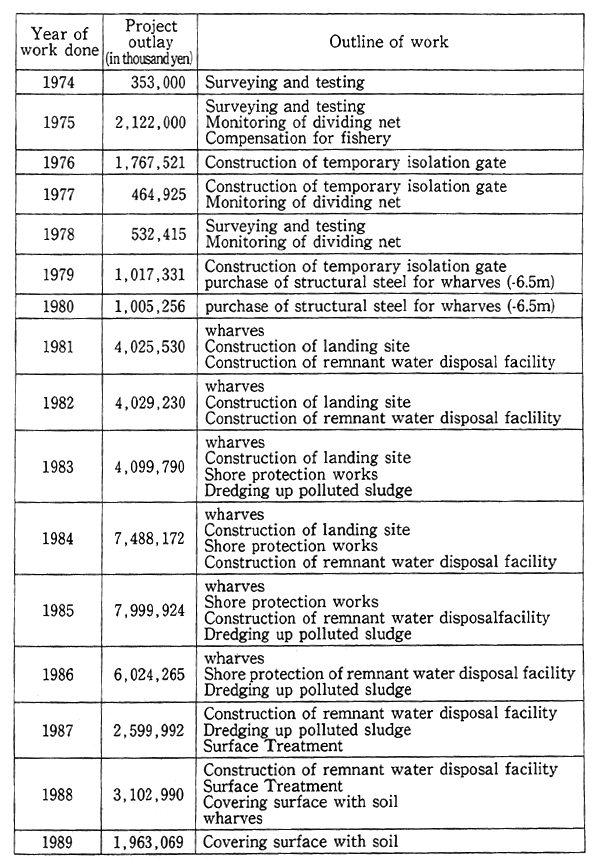
Source: Kumamoto Prefecture
(3) The negative impact on the regional communities
The population of Minamata Village around 1907 was about 10, 000, and the village budget was 20,000 yen in the currency then used (which is equivalent to about 24 million yen in todays money). In 1908, Chisso established its chemical fertilizer in Minamata, and since that time Minamata grew rapidly. In 1912 the village became Minamata Town, and in 1949, Minamata officially became a city. In 1956, the Minamata harbor was opened, and the population reached a peak level of about 50,000. When we consider that during this entire period, the overall population in Japan increased by about 2.5 times, we can see that Minamata City developed and grew fairly rapidly due to the influence of Chisso. (Fig. 2-2-1).
The outbreak of Minamata Disease and its aftermath adversely affected the business of Chisso. The employment opportunities for Minamata City narrowed and shrunk, the economy stagnated, which, in turn, led to both under population declines and aging of the local communities. The population that had been growing rapidly declined year after year, and dropped to below 40,000 in 1970. In the more recent years the population decline has continued (via social decreases), and it dropped to 34,594 persons as of 1990. Similarly with regard to aging of the population, the process has accelerated each year. When we corn-pare the population age composition of Minamata City in 1960 with that in Kumamoto Prefecture overall, we find that the young age population was 2 points more numerous than in the prefecture as a whole, while the elderly population was 1.4 points lower. Thus, Minamata City was younger overall. When we make the same comparison as of October 1, 1990, we find that the younger population of Minamata City is 0.2 points lower, and the middleage population is 3 points lower, while the elderly population is 35 point higher, which indicates that Minamata City has aged considerably in comparison to the overall average for Kumamoto Prefecture.
Fig. 2-2-1 Minamata City's Population and National Population (Index with 1891 populations at 100)
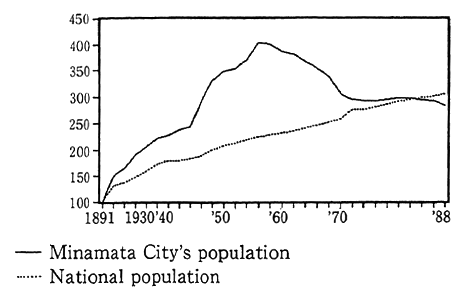
Source: "Japanese Population Since 1872" Cabinet's Statistic Bureau and Minamata City's data.
This kind of population reduction and aging in Minamata City has taken place where there has been a large-scale concentration of population around Kumamoto City. We can infer that the un-precedentedly grave pollution incident caused by Chisso, and the reduced business activity which resulted by the need to pay out huge amounts of compensation have undermined the vitality of Minamata City as a whole, and served as another factor in that population decline and aging process.
When we look at the ratio of employed persons of Minamata City by type of industry in 1960, we find: 41.9% work in primary industries, 34.5% work in secondary (manufacturing) industries, and 23.6% work in the tertiary (service) industries. When compared to the national average (48.5% in the primary industries, 21.8% in the secondary industries, and 29.6% in the tertiary industries), we can see that industrialization started to take place from a fairly early period. Employees of Chisso formed over 70% of all persons employed in the secondary industries. For manufacturing industries, the ratio for 1951 reached 95%, and this ratio stayed at more than 80% until 1954. In a sense, Minamata City developed as an one-company town with Chisso's Minamata plant. (Fig. 2-2-2). However, the total number of persons employed at Chisso Minamata Plant dropped to only one fifth of the peak period to a little more than 900 workers, which was below 20% of the total number of persons employed in secondary industries, and only about 25% of the persons employed in manufacturing industries. Through this reduction of Chisso's work force, the ratio of workers employed in secondary industries in Minamata City stagnated at a level below the national average by 1980, even though the national average increased by more than 10 points compared to the ratio in 1960.
Fig. 2-2-2 Workers in Secondary Industry and Chisso Employees in Minamata City
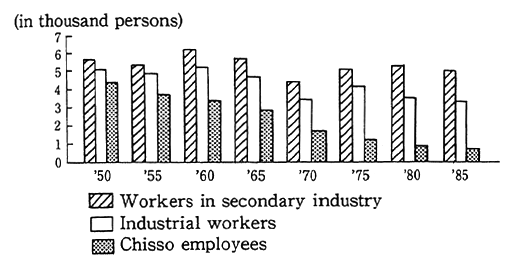
Source Data from Minamata City and Chisso
When we look at the transition in the value of shipments of manufactured products from Minamata City to the total value of manufacturing shipments in Kumamoto Prefecture as a whole, we can see that the demise of Chisso gave a devastating blow to the city's economy. Minamata City's share in the prefecture was rising each year up to a peak of 16.7% in 1960. By 1978, it declined to 8.4%, which is half of the share at the peak period. By 1988, its share in Kumamoto Prefecture was only &7% or only about one fourth of what the city contributed at the peak period. We can see that the drastic cuts in production at Minamata Plant due to Minamata Disease produced a grave impact on the city (Fig. 2-2-3).
Similarly, when we compare the transition in the per capita income in Kumamoto Prefecture and Minamata City in a time series, while the per capita income was higher in Minamata City consistently up to 1976, the relative position was reversed in 1977 and thereafter, and the gap has been growing even larger in recent years (Fig. 2-2-4).
Fig. 2-2-3 Products Shipped from Minamata City and those from Kumamoto Prefecture
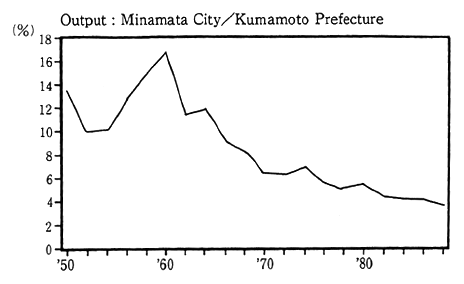
Source 'Census of Manufactures" by the Ministry of International Trade and Industry and Minamata City's date
Fig. 2-2-4 Income Differentials (Minamata City vs, Kumamoto prefec-ture)
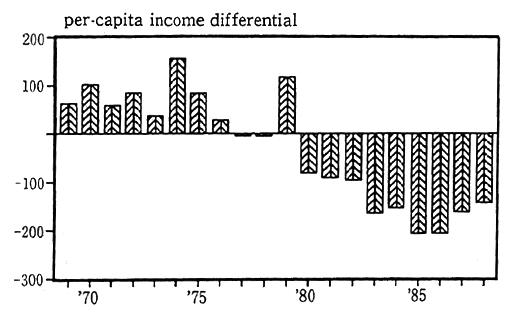
Source "Annual Report on Calculation of Prefectural Residents' Economics" and Minamata City's date
Let us now look at the changes in the contribution of Chisso to the finances of Minamata City by checking the ratio of tax paid within the overall tax revenue. In 1960. Chisso's Minamata Plant accounted for nearly one half of the tax revenue of the city. However, as Minamata Disease became a serious social problem, the tax payment from the plant declined to 25% by 1965. As of 1988, the tax payments from the plant made up only slightly more than 9% of the city's tax revenues. We can see how the share of Chisso-related tax revenues within the overall tax revenues of the city declined sharply due to the reduction in produc-tion at Chisso's Minamata Plant (Fig. 2-2-5).
Fig. 2-2-5 Share of Tax Revenue from Chisso Inc. in Minamata City's Tax Revenue
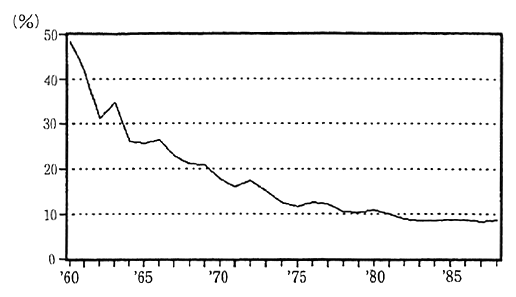
1. Tax revenue from Chisso Inc. VS. that of Minamata City
2. Source: Minamata City's date
As the tax revenues from Chisso declined in this way, the reve-nues of Minamata City, which had been dependent on Chisso, began to grow much more slowly. When we look at the share of Minamata City' s tax revenues within the overall tax revenues of all the cities, towns, and villages in Kumamoto Prefecture, Minamata City's share was increasing each year up to 1960, but since then, the share has been declining. During this period, we see that the share of Chisso has been roughly parallel to the declining trend of Minamata City, and so, we can see that the failure of Chisso-related tax revenues to grow has been largely responsible for the stagnant growth in the tax revenues of Minamata City (Fig. 2-2-6).
Thus, the question of how to develop Minamata City, whose economic and social foundation has been weakened in this way, became an important issue. Accordingly, in 1978, the national government reached a cabinet approval making recovery and development measures for the Minamata region as an integral part of the overall policy to deal with Minamata City (under the title of "On Measures To Deal With Minamata Disease"). Based upon this Cabinet approval, Kumamoto Prefecture formulated the "Minamata-Ashikita Region Development Project" starting in 1979. This project set the following goals: (1) Development and improvement of transportation networks and other conditions related to the social infrastructure, (2) Improvement of the social environment centered around development of social services, insurance and medical care programs, and life environment, (3) Indus-trial development consisting of agriculture, forestry, and fisheries indus-tries, development of commerce and manufacturing, etc. Through this project the prefectural government has been actively implementing various types of measures to achieve these goals with the aim of developing and revitalizing this whole region.
Fig. 2-2-6 Shares of Tax Revenue of Minamata City and that from Chisso Inc. in Kumamoto Prefecture's Municipality Tax Revenue
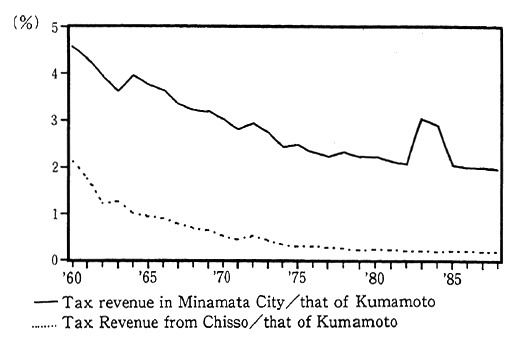
Source: "Annual Report of Local Financial Statis-tics" by the Ministry of Home Affairs, Minamata City's date, etc.
(4) Impact on the business of the company responsible for pollution contamination
Chisso's Minamata Plant could well be described as a typical plant in the chemical industry in Japan of that period. It actively introduced technology from overseas, and it was credited with a large number of chemical products that were produced first in Japan in its facilities. Even though it was a late-starter in the industry, the company achieved an amazing growth and development through expansion to Korea in the prewar days. Even though it received a devastating blow during World War II, it was able to recover with its distinctive techno-logical capability, and so, for a period of time in the post war years, it was a leading company representing the chemical industry of Japan.
However, the outbreak of Minamata Disease imposed tremen-dous damage on the business of Chisso, the polluting company itself, because of the mandated large compensation payments.
When we look at the transition in the size of internal reserves, and compare those with the average for the chemical industry overall, and with other companies of about the same size in the chemical industry (Company A), we find that the trends were about the same up to the year 1967. However, after 1972, while the average for the chemi-cal industry over-all and the size of the internal reserve at Company A grew steadily, Chisso suffered huge losses due to yearly payments of compensation, and the losses become cumulative (Fig. 2-2-7). During this period, the sales of Chisso continued to grow, even though the rate of growth was somewhat slower than the industry average (Fig1. 2-2-8). Ordinary profit maintained a fairly good level as well. Considering these points, then, we can clearly see how the company's burden in having to make the compensation money, etc., each business term, undercut its financial structure in a severe manner. Similarly, when we compare the transition in Chisso's capital and total assets with the average for the industry and the companies that were roughly equal in size in 1964 (Company A and Company B), we find that ever since the 1960's when Minamata Disease became a serious social problem, both the capitalized amount and total assets for Chisso did not grow, while the total number of employees dropped sharply. Overall, it shows a contrasting trend from the trend of the chemical industry as a whole ((Fig. 2-2-9, Fig. 2-2-10, and Fig. 2-2-11). Furthermore, aside from the losses that can be quantified in this way, it can be imagined that the drop in its image as a polluting company responsible for contamination has been of immea-surable proportions. Thus, even though at the time of its start, Chisso was one of the leading companies in the chemical industry of Japan (along with Company A and Company B), with a business condition that was better than the chemical industry average, the burden for the huge costs for the damages it produced, those costs resulted in a serious brake to its development.
Fig. 2-2-7 In-house Reserves
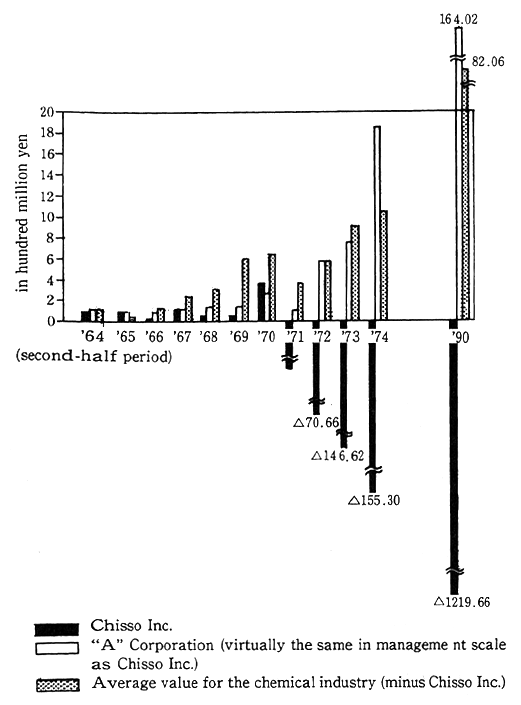
Source: Mitsubishi Research Institute, Inc.: "Analysis of Corporate Management"
Fig. 2-2-8 Proceeds Comparison
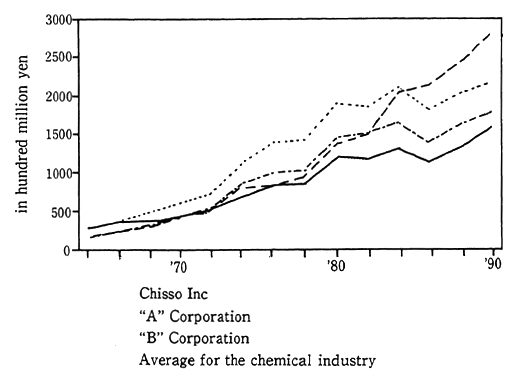
Source: Mitsubishi Research Institute, Inc.: "Analysis of Corporate Management"
Fig. 2-2-9 Capital
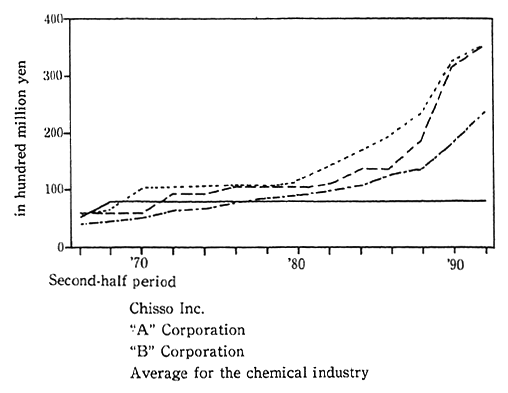
Source: Mitsubishi Research Institute, Inc "Analysis of Corporate Management"
Fig. 2-2-10 Total Asset
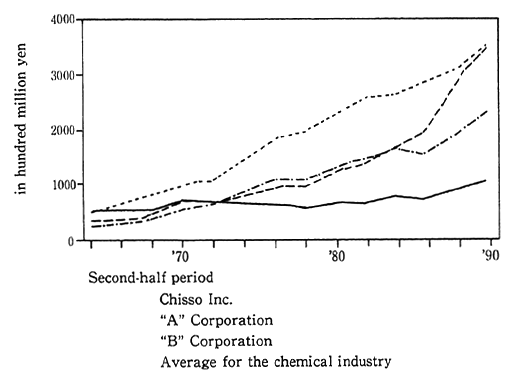
Source Mitsubishi Research Institute, Inc "Analysis of Corporate Management"
Fig. 2-2-11 Number of Employees
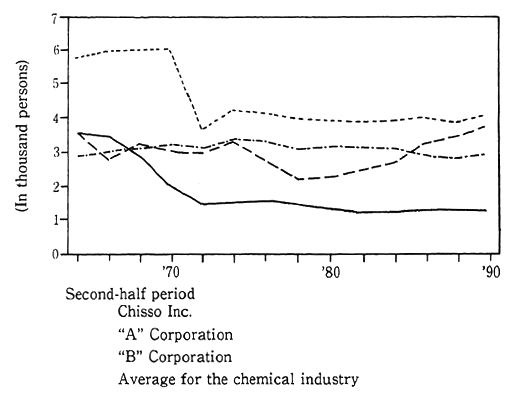
Source: Mitsubishi Research Institute, Inc.: "Analysis of Corporate Management"
When we take the state of Chisso's financial affairs about 1960, it certainly was not any weaker than the average for the chemical industry; in fact, it was stronger. At that point, the company was in a good position to bear the full cost of instituting the necessary pollution control measures. Thus, we can say that inadequate pollution prevention in the initial stage undermined its development in the subsequent years.
The compensation money for the Minamata Disease patients is paid by Chisso, but because Chisso's business and financial conditions deteriorated so seriously, serious concerns arose about the company's ability to pay the compensation after 1975. In view of this situation, in June 1978, the Cabinet requested concerned financial institutions to provide financial assistance so as to ensure that there would be no problems for the payment of compensation money to patients, and to contribute to the stability of the local community and economy, while adhering to the polluter pays principle. Based upon this Cabinet approval, a method has been employed whereby the Kumamoto Prefec-ture issues a prefectural bond, a certain portion of which is accepted by the fund management division of the national government, and the funds raised in this way, then are loaned to Chisso for meeting its compensa-tion obligations.
Even thirty-five years after its official discovery, Minamata Disease is still with us as a social problem whose solution is vitally important. In this way, once an incidence of pollution contamination occurs, the recovery from it is likely to be extremely difficult, and loss of life and other irreparable damages occur in many cases. It goes without saying that the pain and agony suffered by victims is tragic, anti there are immeasurable consequences for the life and development of the communities involved, anti oven for the polluter company itself.
While Minamata Disease is the most extreme case, in Japan during the rapid economic growth period, there were a large number of cases of industrial pollution damage, both small and large, all across the country. For example, toxic heavy metals discharged from mines and factories caused much contamination of agricultural soil. In order to get an accurate grasp of the true situation, a detailed survey on measures to prevent contamination of soil for agricultural use has been in place since fiscal year 1971 in those areas where this hazard exists. As of November 15, 1991, contamination that goes beyond the maximum standard level which is set under the Agricultural Land Soil Pollution Prevention Law was found in 7,050 hectares, and of this total, countermeasures have not yet been taken for 2,690 hectares(Fig. 2-2-12). Also, with regard to the pollution-related health victims who are assessed to have become afflicted with an illness such as asthma due to the effects of atmospheric pollution (patients certified to have a designated disease in a Type 1 area under the Pollution Pollution-related Health Damage Compensa-tion and Prevention Law), the total amount of compensation paid from 1974 to 1988 came to more than 990 billion yen (which is equivalent to about 1,102 billion yen in today's prices), and in the fiscal year 1989, a total of 106 billion yen was paid to 101,258 persons.